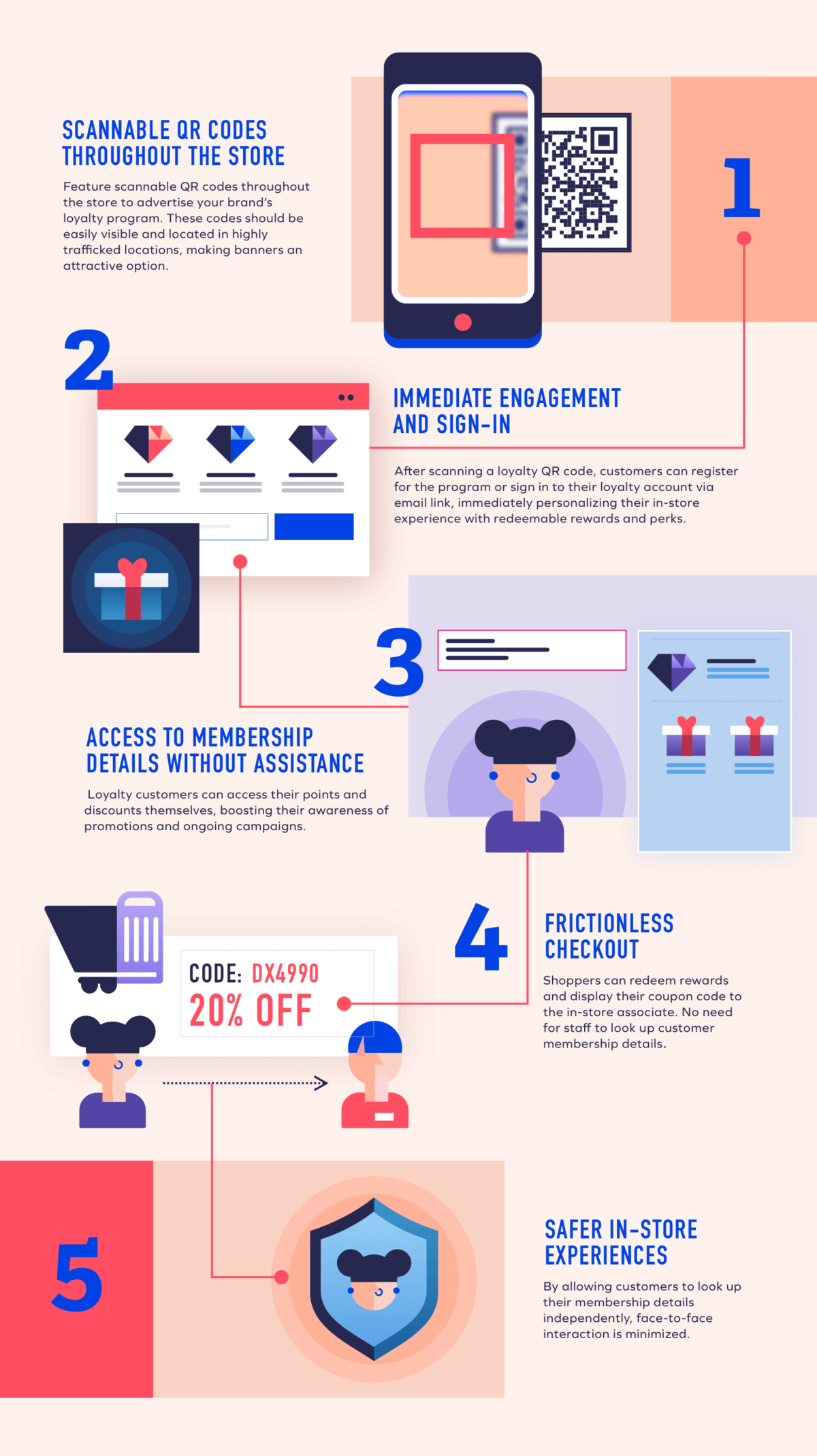Before 2020, retail was king. While digitally native D2C brands were well on their way to redefining consumer behavior, established companies primarily focused on their in-store experiences. No one was prepared for the boom online purchases saw in 2020 through to today — shopping became ubiquitous with eCommerce, and even traditional brick-and-mortar retailers began to double down on online experiences.
But, another shift is taking place. As we approach a new normal, retail is entering a renaissance. In fact, according to the National Retail Foundation’s annual forecast, retail sales increased between 6 and 8% in 2022. While online shopping may still be the preferred channel for many consumers, it’s no longer the default.
Now more than ever, customers’ buyer journeys are nonlinear. And they’ll continue to diversify as our new normal takes shape. Brands have to meet shoppers wherever they feel most comfortable, making an omnichannel loyalty experience necessary.
What is omnichannel loyalty?
Omnichannel loyalty allows shoppers to earn and redeem points in-store, online, and through other channels, like social media. It ensures that customers can experience VIP-level service wherever they choose to shop and prioritizes their comfortability during this transition period.
Yotpo’s approach to omnichannel loyalty supports online-offline connectivity, which includes sharing data across the two channels and creating unified shopper experiences.
Omnichannel loyalty is a business-defining investment
Loyalty members are key to your bottom line, especially with the current unpredictability of retail. According to Accenture, 57% of consumers spend more on brands to which they are loyal. But, customers expect a clear value exchange for their loyalty, meaning their VIP experience needs to carry through every touchpoint, including in-store.
The experience of a loyalty program – rewards, perks, loyalty points, VIP tiers, personalized experiences – makes customers return to a brand and advocate for it. With Yotpo Loyalty & Referrals, loyalty doesn’t have to be compromised as customers switch from one channel to another.
Accommodate for retail’s return
As your company continues to build out its omnichannel strategy, ensure your loyalty program follows suit. Over a quarter of shoppers (25.2%) say that their biggest frustration with loyalty programs is the retail disconnect. Accommodating your highest-value customers’ needs and prioritizing their experience pays off in dividends, meaning increased AOV, LTV, and repeat purchases.
Differentiate yourself from competitors
Many loyalty programs cater exclusively to online or in-store shoppers; few accommodate both. With 35% of American buyers trying a new way of shopping in the past year alone, many of whom report a “high intention” of continuing these habits, traditional loyalty programs will be sidelined.
Remaining agile and investing in customers’ omnichannel buying journeys will keep your loyalty program relevant, and more importantly, effective. Set yourself apart by innovating early and allowing customers to earn points wherever they prefer to shop. The omnichannel customer is here to stay.
Own the data on your customers’ path to purchase, end to end
Loyalty membership gives consumers a reason to self-identify, providing your organization with invaluable first-party data. But, without bridging the gap between online and in-store loyalty experiences, you’re creating information gaps. Omnichannel loyalty programs create a 360-degree view of your customers, ensuring you know how consumers shop in-store and online.
Let loyalty customers take charge
Omnichannel shopping is here to stay because it prioritizes customer experiences, and by extension, customer well-being. Shopper safety and comfort are now more critical than ever. Companies need to take stock of how and where their loyalty customers feel most comfortable, even within individual channels.
Successful loyalty programs are customer-centric. For brick-and-mortar retailers, customer-centric should mean customer-led. In-store shoppers may feel nervous about embracing pre-Covid shopping behaviors. But with customer-led redemption, in-store loyalty programs become a point of ease rather than anxiety.
What is customer-led redemption?
Wherever shoppers feel most comfortable, Yotpo’s in-store point-of-sale integration empowers consumers to take control of their loyalty experience.
Scannable QR codes throughout your store prompt customers with an email link to sign in or register for your brand’s loyalty program. From there, customers can use their mobile devices to monitor their loyalty status, earn points, and redeem rewards as they shop. After choosing an available discount, shoppers have a corresponding barcode scanned by a store associate for a frictionless checkout.
Why customer-led redemption works
Customer-led redemption breaks down barriers with buyer hesitation. Shoppers have redeemable rewards at their fingertips, sidestepping any embarrassment they may feel when asking sales associates about discounts. Additionally, with more awareness of ongoing promotions and their loyalty status, customers are incentivized to buy. According to Bond, 66% of consumers modify their brand spend to maximize loyalty benefits.
Customer-led redemption makes in-store loyalty seamless. Less 1:1 interaction prioritizes customer safety, and checkout becomes more efficient. Shoppers don’t have to recite email addresses or phone numbers — they already have their coupon code ready. Companies also don’t have to rely on associates to drive loyalty engagement, which can be costly and time-consuming.
Brands can go to market quickly
Companies can launch customer-led redemption quickly and easily. It doesn’t require any changes to the UI of the POS for store associate look-up. Instead, Yotpo’s Loyalty and Referrals solution integrates with a company’s POS directly, managing customer details to confirm discounts, order data, customer data, and refund data.
Customer-led redemption in action
Let’s walk through customer-led redemption in action, from awareness to purchase.
The infographic below outlines an engaging and safe in-store experience for customers leveraging a brand’s loyalty program via scannable QR codes. Strategically placed codes throughout the store allow customers to instantly register or sign in, allowing for a personalized shopping experience.
Via these QR codes, customers gain instant access to membership details, points, discounts, and promotions. This seamless process facilitates frictionless checkout experiences where customers can effortlessly redeem rewards without requiring assistance from store staff, which leads to a safer, minimized face-to-face in-store interaction.

Get started with omnichannel loyalty
As omnichannel ecosystems become the standard, an effective loyalty program now needs to engage customers at every touchpoint. Customer-led redemption seamlessly connects the highly personalized loyalty program you’ve created online with your in-store experience, all while prioritizing customer well-being. Interested? Request a demo.
Omnichannel loyalty FAQs
What is omnichannel marketing?
Omnichannel marketing is an approach that aims to create a seamless and integrated customer experience across all available channels and touchpoints. It involves coordinating marketing efforts across various platforms, such as online, social media, in-store, mobile, email, and more, to deliver a consistent message and personalized experience to customers throughout their buyer journey.
What is an example of an omnichannel approach?
An example of an omnichannel approach is a customer being able to start browsing products on a retailer’s website, add items to their cart, and then continue their shopping journey in-store. While in-store, they can access their online shopping cart on their mobile device, and upon checkout, they may use a combination of loyalty points earned from both online and in-store purchases to make a payment. This seamless experience across channels demonstrates an omnichannel approach.
What is omnichannel vs multichannel approach?
The omnichannel approach focuses on delivering a cohesive and consistent customer experience across all channels, ensuring that each channel complements and integrates with others. On the other hand, the multichannel approach utilizes multiple channels to reach customers but may lack the seamless integration and consistent messaging found in an omnichannel strategy.
What is the difference between omnichannel loyalty and traditional loyalty programs?
Traditional loyalty programs often focus on rewarding customers solely for purchases made through a specific channel, like an in-store rewards program or an online points system. In contrast, omnichannel loyalty programs reward and engage customers for their purchases, interactions, and engagement across various channels, allowing customers to earn and redeem loyalty points both online and in-store.
How can omnichannel loyalty benefit my business in the retail industry?
Omnichannel loyalty can benefit your business by increasing customer engagement, retention, and advocacy. By offering a seamless loyalty experience across channels, customers are more likely to stay loyal to your brand, spend more, and become advocates who promote your brand to others.




